If you work remotely, you’ve probably used Zoom at some point.
Yet, you might not know Zoom is also one of the pioneers in noise cancellation technology. If you make conference calls, you know how distracting and annoying background noises can get.
Keyboard typing, barking dogs, and crying kids – all these noises can affect the productivity of your call.
Thankfully, Zoom provides the capability to eliminate these unwanted sounds, facilitating professional-quality conference calls. However, it’s important to note that Zoom noise suppression features may not always perform optimally. By delving into the specifics of Zoom noise cancellation, users can markedly improve the audio quality of their meetings. On a separate note, fine-tuning the settings for Zoom noise suppression can further aid in reducing background distractions.
In this guide, we’re going over how you can get started with background noise removal on Zoom and try advanced methods for cancelling unwanted sounds and echoes.
- What is Zoom noise cancellation?
- How to turn off Zoom noise cancellation?
- How do I reduce background noise in Zoom?
- How to cancel out background noise completely?
- More tips for better Zoom meetings and high-performance sound
What is Zoom noise cancellation?
August 2018. Zoom just announced and added the long-awaited persistent background noise cancellation feature. According to Zoom, this function automatically detects and blocks background noise, such as keyboard typing.
This function is switched on by default, so you don’t have to do anything in the settings. When you make calls using Zoom, noise cancellation automatically works in the background, and you don’t need to worry about turning it on.
However, sometimes you don’t need to remove background noises completely. For example, if you’re teaching online guitar classes, the enabled noise cancelling feature will do more harm to you than good. That’s because your students simply won’t hear you playing. In such cases, it’s better to turn off the default Zoom noise cancellation feature.
How to turn off Zoom noise cancellation?
To disable the Zoom noise cancellation feature, you need to enable the preservation of original sound. It’s not as difficult as it sounds.
Preserving the original sound means that other call participants will hear the original audio from your microphone, without the audio-enhancing effect and noise cancelling feature of the app.
This option is great when you have a high-quality microphone. Or, maybe you just want the other call participants to hear clear audio like in the case with music classes.
So if you’d like to turn off Zoom noise cancellation, you’ll need to enable preserving original sound:
- Log in via your Zoom desktop client and click on your profile picture.
- Select Settings > Audio.
- Under Music and Professional Audio, you’ll find the Show in-meeting option to enable “Original Sound” feature.
To suit your exact event type, you can select the High fidelity music mode, Echo cancellation, or Stereo audio.

And, that’s it.
Now, the Original Sound setting will show up in the top left corner of your next meetings. No extra updates needed.
You can also do this on a mobile app:
- Sign in to the Zoom mobile app and tap the Settings button.
- Choose Meetings.
- Under Audio, turn on the Use Original Audio toggle.
How do I reduce background noise in Zoom?
To do this, you only need to take a few steps:
- Open Zoom’s desktop app on your Mac or Windows device.
- Click on the Settings icon.
- Select the Audio section.
- Under the Suppress background noise section, select the level of suppression you need for your most common use cases. Auto is the default setting but this will commonly apply moderate background noise reduction. It can also adapt to new sounds it detects in the background, but won’t treat background music as an unwanted sound. We’d recommend opting for the High level if you want to reduce sounds like wrappers flying around, paper crunching, or keyboard typing.
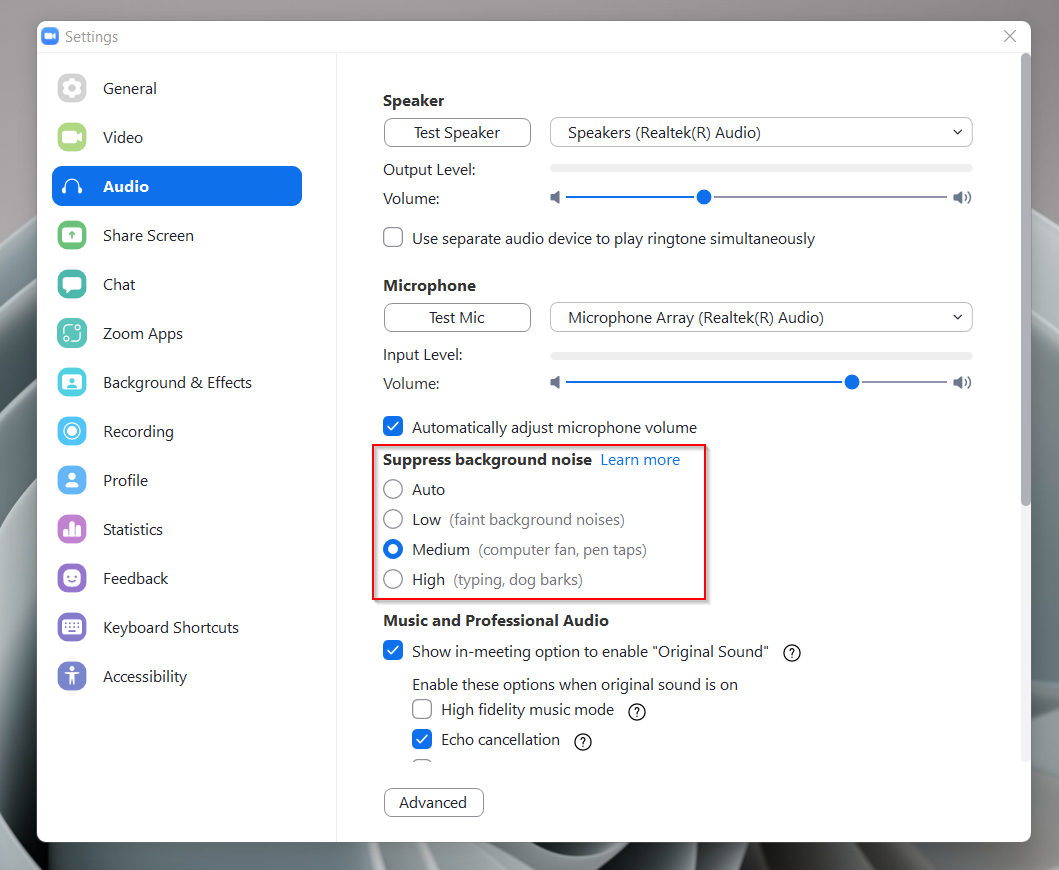
How to cancel out background noise completely?
But Zoom’s noise-reducing capabilities don’t completely remove background noises. Sometimes there’s so much persistent background noise that the built-in noise cancellation may not be enough.
Or maybe you often switch between communication apps, making work calls with Zoom, personal calls via Google Meet, and sending quick video messages through Loom.
In such cases, Krisp can help you cancel out background noise and have a productive noiseless experience.
When considering Zoom vs Google Meet, it’s essential to compare their noise cancellation features, as each platform offers different strengths in minimizing distractions during calls.
What is Krisp?
Krisp is an AI-powered noise cancelling app that removes background noise from your calls with one click. With a single click, it helps you have a productive and professional conferencing experience without background noise.
Plus, Krisp can block background noise on both ends of the call. You can cancel noise on your side with Krisp Microphone so that other call participants can only hear your voice. Conversely, if there is a lot of background noise coming from other participants, Krisp Speaker can help you don’t hear their noises.
[demo-new]
It seamlessly works with any conferencing app, including Zoom. Here’s how you can easily set up Krisp with Zoom.
1. Download the Krisp app.
2. Follow the Krisp Setup Wizard instructions to install Krisp.
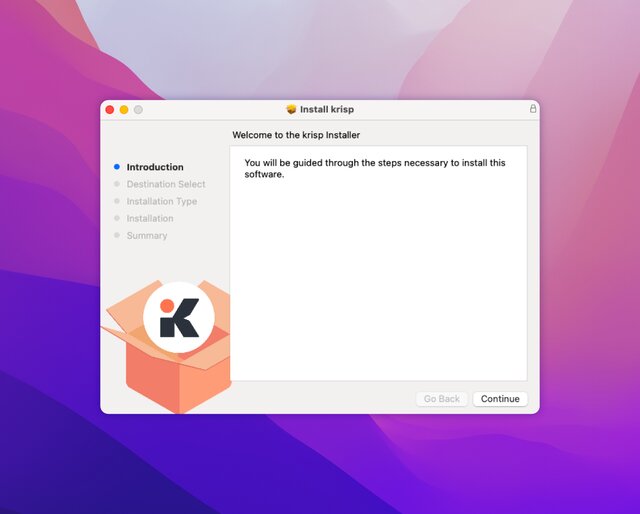
3. After this, open Zoom and select Settings > Audio tab.
4. From there, select Krisp Speaker and Krisp Microphone.

5. Now start a Zoom call and switch on the Remove Noise toggle in Krisp.
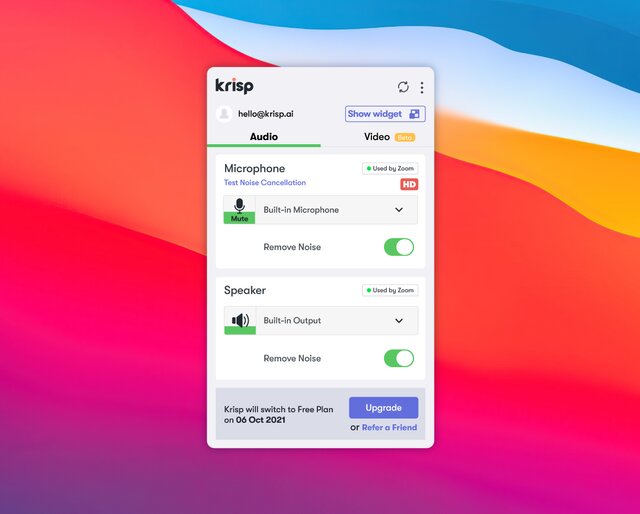
That’s all! Try Krisp app during your next Zoom call and feel the difference for yourself.
Wondering how Krisp compares with classic Zoom noise cancellation? Take a look at this video review:
If you’re a Mac user, here’s a helpful video on how to set up Krisp with Zoom on Mac to start removing common noise distractions.
If you don’t have the Zoom app installed yet, download Zoom for Mac.
And if you’re a PC user, here’s the tutorial on how to set up Krisp with Zoom on Windows.
How can I remove echo in Zoom?
Zoom has a built-in echo cancellation feature which, in most cases, is turned on by default:
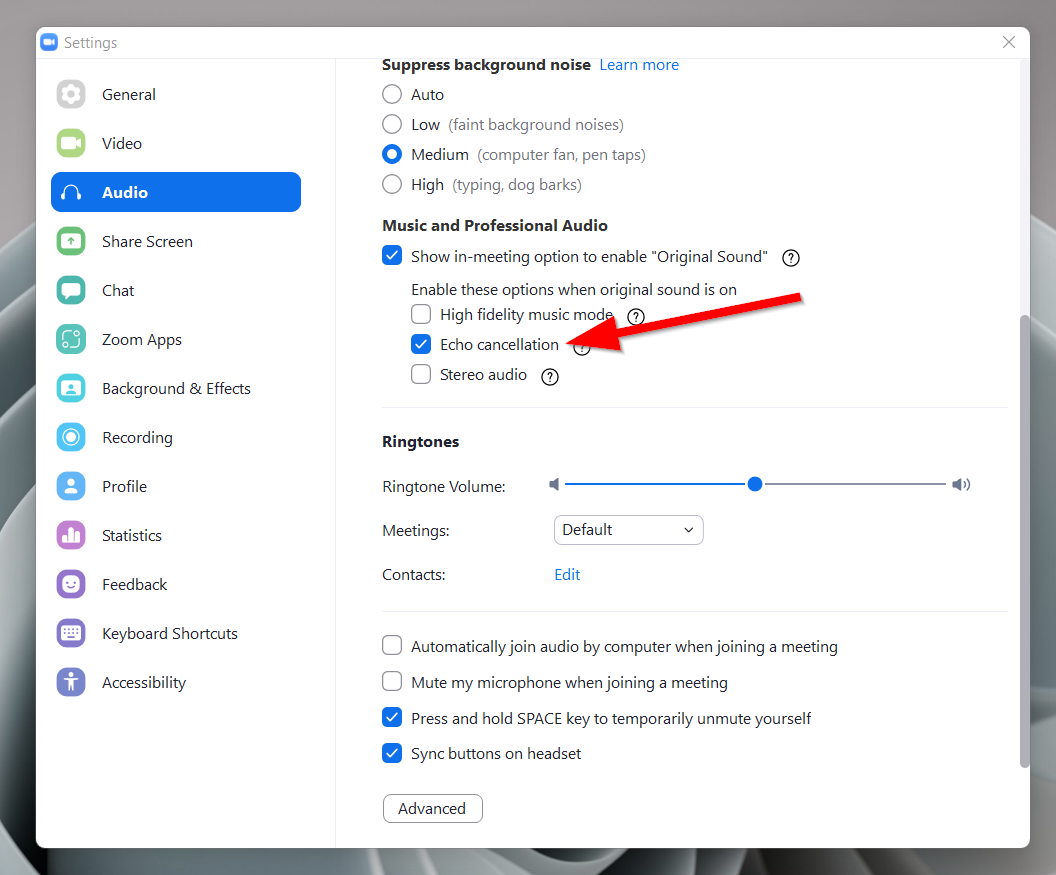
You can further edit its effectiveness by heading over to your profile picture icon > Audio > Advanced:
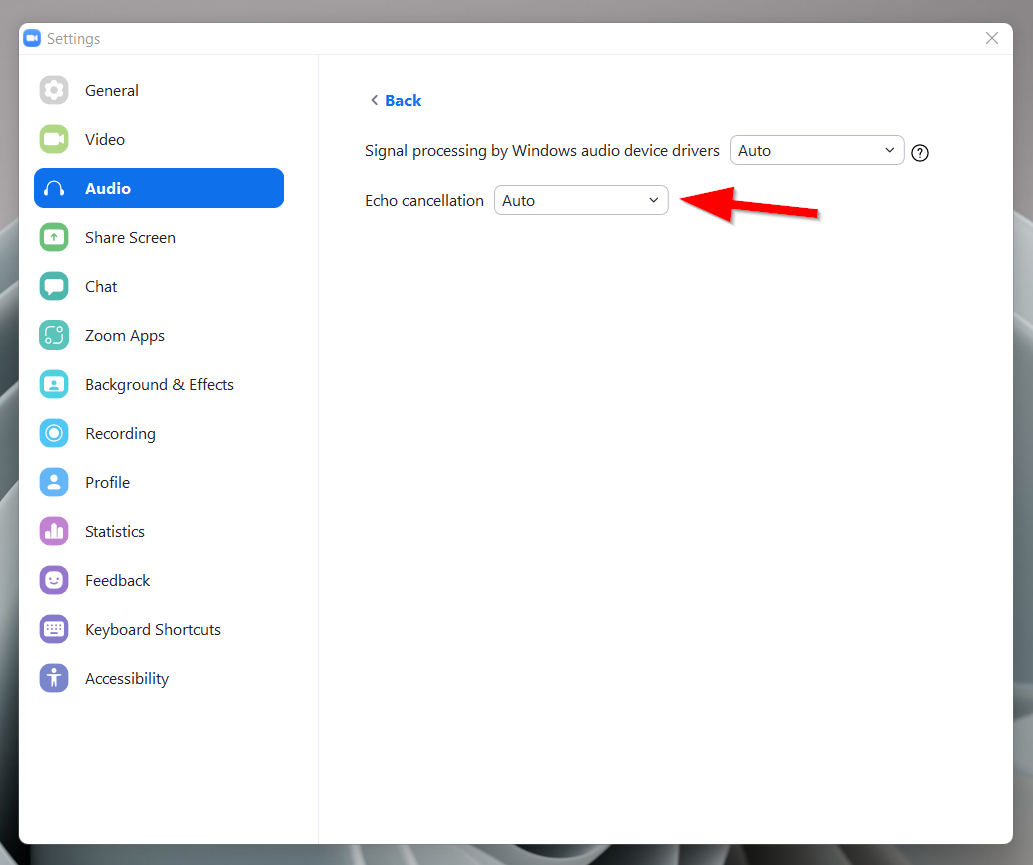
There you currently [Zoom keeps changing the way they manage echo] have the option to choose between Auto and Aggressive. Auto echo cancellation works best for online events with multiple participants and an audience or for live music events. The Aggressive option, on the other hand, is best suited for regular meetings where no echoes are welcomed as they can disturb the session.
Krisp takes echo cancellation one step further by removing the echoes bouncing off of the walls or other hard surfaces in the room you’re taking your call from. So you can literally take calls from anywhere. On top of this, Krisp even takes care of pesky acoustic echoes your overly-sensitive microphone could cause. Zoom currently has no solution for the latter recurrent problem.
More tips for better Zoom meetings and high-performance sound
Background noise cancellation and echo removal are just two of the many aspects to consider for a high-quality Zoom session. I’ll also take you through some extra tricks for guaranteeing the quality of your audio, whether it’s for live meetings or recordings:
Using the right equipment
Whether you’re using Zoom’s noise cancellation independent or alongside Krisp, both tools work with any headset or earset including a wireless or corded headset and mic.
A condenser mic though is best suited for voice recordings like webinars or podcasts. Condenser mics are more sensitive and responsive, while dynamic ones are suited for extreme conditions and work for musical performances where you’ve got both singers and a complete band on the same stage.
You’ll also want to add in a pop filter or windscreen if you want to record outside on a windy day or you’ve had enough of the “p” and “b” sounds that distort your final recording.
Bonus tip: An appropriate environment plays a huge part in the quality of a recording. While Krisp helps you get that HD voice recording, if you plan on using Zoom’s noise cancellation only, you’ll appreciate shock absorbers across your recording room.
[demo-new]
Maintaining peak device performance
Zoom noise cancellation can increase CPU utilization. So you’ll want to use it sparingly for important events like webinars or other types of live streams. However, Zoom noise cancellation feature is specifically designed to enhance audio quality by filtering out background noise, making it indispensable for professional and clear communication.
For these, however, it’s super important to maintain a high-quality sound. So instead of ditching noise cancellation, use a tool like Krisp which requires less work from your system. Just switch to the optional low power mode when you’re running many taxing programs to minimize CPU usage. Talk about the best of both worlds!
Improving Zoom meeting quality in time using past insights
In addition to noise and echo cancellation, Krisp pairs with HD-supported devices to maintain crystal clear audio quality at all times. This is perfect for podcasts or events you need to record as you won’t need to take the entire recording through a complex post-editing process.
Besides audio quality, you’ll also want to consider improving your communication skills and providing a top-notch meeting experience to your team, clients, students, or event attendees.
Krisp’s Talk Time gives you real-time insight into your meeting participation by showing you how much time you spent speaking during a call. This allows you to keep your own engagement in check and know when it’s time to let others speak.
If you want to prevent wasting too much time in Zoom sessions, just track call performance using Krisp’s Call Summary. This answers common questions you might have had before like:
- How long do our meetings usually last?
- How much time is every person speaking? Are there any meetings where we’re losing precious time in silence?
- How much noise has Krisp canceled?
Bonus tip 2: If you’d like transcripts for your Zoom meetings, check out how to transcribe zoom meetings free using Krisp’s AI Meeting Assistant feature.
For seamless and cost-effective transcription of your Zoom meetings, consider leveraging the innovative Krisp’s AI Zoom Transcription feature, which utilizes advanced artificial intelligence to accurately and effortlessly convert your meeting conversations into text.
Wrapping up
Hopefully, this tutorial will help you to block background noise from your Zoom meetings and enjoy productive conference calls. If you have any questions, ask us on Twitter.



